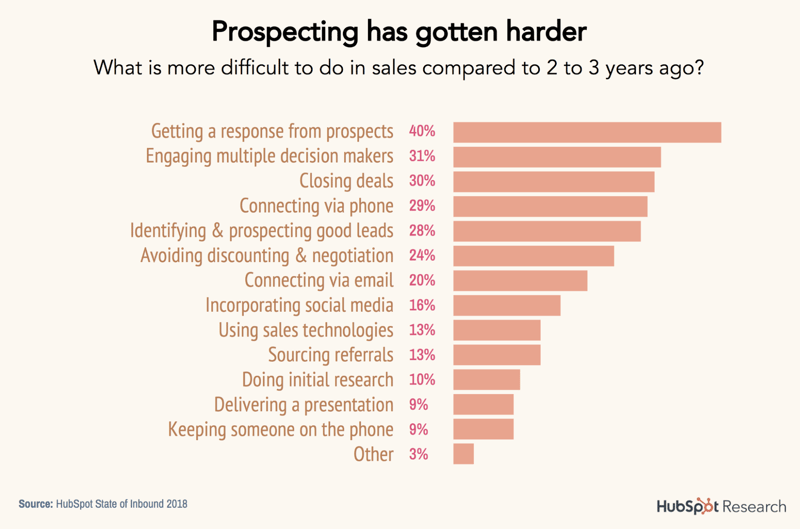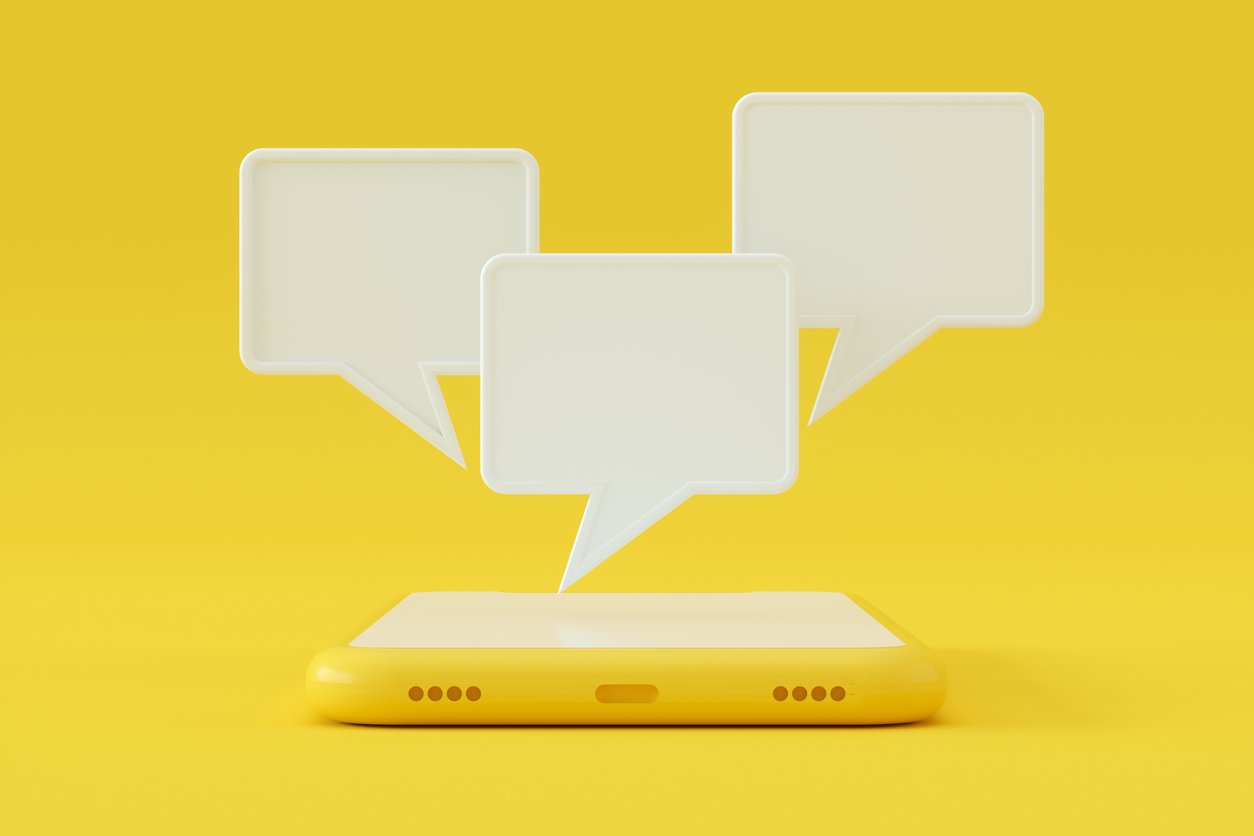
A Sales Professional’s Guide to Successful Cold Email
 Updated on
Updated on
 By Katie Bowman
By Katie Bowman
Katie Bowman
Katie has extensive experience in customer service and enjoys the opportunity to help others. She is committed to providing high-quality service and d...
learn more
Katie Bowman
Katie has extensive experience in customer service and enjoys the opportunity to help others. She is committed to providing high-quality service and d...
Table of Contents
Table of Contents
Reaching your prospects, getting a response, and closing the deal is harder than ever.
And no, it's not just a gut feeling.
This piece of HubSpot research shows the true extent of the problem:

But why is this happening?
Because of information overload — the average person has to stomach 13 text messages, 121 emails, and 6,000-10,000 ads every single day...
No wonder leads are lightning-quick to ignore emails and click "delete" on anything that sounds suspicious.
Does this mean cold outreach is dead?
No, it simply means most salespeople and marketers are misusing communication technology, and consumers have caught on.
One look at email marketing's 4,200% ROI potential is enough to prove our point.
So the question beckons: "how can I up my cold email game?"
And so does the answer: invest 25 minutes in this comprehensive guide and find out.
Need a preview of what you'll learn before we start? Good thinking:
- All the cold email basics
- The five major challenges preventing success
- How to write a cold email (including templates and best practice tips)
- The best cold email software
Now let's get moving; time is money.
What is a Cold Email?
Since we only met a couple of minutes ago, it's wise to take it slow and start with a definition of cold emails.
Maybe you already know about cold emails, but bear with us; we'll be quick, and a bit of repetition "never hurt nobody."
A cold email has nothing to do with temperature. It's simply an "ice-breaking" email you send out to someone you don't know as a means to start a conversation.
People use them for sales (or remote sales), networking, recruiting, and link building.
But regardless of your cold email's purpose, you need to make sure there's a legit reason behind contacting the other person.
A.k.a. don't send an email about CRMs to a nuclear physicist that works in academia.
Because if you do, your cold email could be perceived as a spam email. And:

The subject of spam email brings up a good question:
Is a Cold Email a Spam Email?
In a word, no.
A cold email is a legitimate way to communicate with a person who doesn't know you or your company yet, while a spam email is simply unwanted junk.
But unfortunately, there's a thin line between the two, and it's been confusing people since the beginning of time (well, ok, since Ray Tomlinson sent the first email in 1971).
A cold email can become a spam message if it ignores the legal requirements (i.e., the CAN-SPAM Act) and the best practices of proper cold outreach.
How can you tell the difference?
A cold email must:
- Reflect the recipient's interests or occupation
- State whether or not the email is an advert
- Be personalized one-to-one communication
- Include the sender's company name and business address
- Give recipients an opt-out message/link and honor any such request
- Be free from:
- Deceptive subject lines
- False or misleading header information
- Misrepresentations
Follow these simple points, and your emails will never be spam mail.
So how do you put cold email to good use?
Typical Circumstances Where Cold Emails Are Used
Businesses send cold emails for a large variety of purposes, including:
|
Circumstance |
Why It's Helpful |
|
Find a referral |
|
|
Connect with new prospects |
|
|
Build awareness |
|
|
Share thought leadership |
|
|
Run an intro drip campaign |
|
|
Ask for favors |
|
Cold emailing sounds easy, right?
All you need to do is ensure it's not spam and then send it for a valid reason, right?
Not quite.
These are just the basics, but you need to master this dark art to really succeed with cold emails.
Why?
Because thanks to those inconsiderate salespeople and marketers we mentioned in the introduction, each cold email faces a seriously steep mountain to climb.
So, let's break that mountain down into five bite-sized pieces.
The 7 Significant Challenges Related to Cold Email

1. Low Open and Response Rates
Cold emails often face two major hurdles: dismal open rates and even lower response rates. People are naturally cautious about emails from unknown senders, especially with inboxes flooded by irrelevant or poorly written messages.
Here's a sobering fact: the average email open rate hovers around 32.55%, but poorly executed cold email campaigns often see rates drop below 10%. And it doesn't stop there—response rates for cold emails average a mere 1%. That means you could send 100 emails and get only one reply, which might still end in a rejection.
These challenges underscore the importance of crafting compelling cold email subject lines and tailoring your message for your audience. A thoughtful, personalized approach can help overcome these obstacles and make your campaign more effective.
2. Wrong Time, Wrong Person
Finding the right person to email is difficult enough, but knowing when to send them an email is even more challenging.
And we're not just talking about the choice of time and day here.
That's nowhere near as important as answering the following questions:
Do they already have a supplier? Are they potentially on the market for my services? Are they going through a busy period in which their to-do list looks like the Burj Khalifa?
Get it wrong, and you'll never get a reply (like 99% of cold emails).
3. Being Perceived as Pushy or Low-Value in Cold Emails
Cold emails often stumble when they come across as pushy or fail to convey value. Recipients quickly delete emails that seem overly aggressive or self-centered. Even well-meaning senders can unintentionally sound pushy, as email communication is prone to misinterpretation.
On the other hand, many cold emails miss the mark by focusing too much on the sender—boasting about their products, accolades, or company—without addressing the recipient's needs. Repeated follow-ups without offering value only reinforce a spammy reputation.
To stand out, your cold email should prioritize the recipient, clearly communicate a strong value proposition, and maintain a tone that's engaging, not pushy.
Newsflash: nobody cares about what you're doing unless you clearly (and briefly) explain how your actions can benefit them.
It's a fact of life and the basis for the What's In It For Me? (WIIFM) Principle.
By this point, your enthusiasm for cold emails has probably faded, and you're feeling a little bit like Elmo in the middle of a blizzard on "Cold Email Mountain":
But don't panic yet; the snowstorm is about to pass, and you're on the verge of learning how to conquer mountains better than Lance Armstrong (without the steroids).
Just keep pedaling, and we'll do the rest by introducing you to the secrets of effective cold emails.
If you give it until the end of this post, we promise you'll feel a lot more like this:
4. Compliance with Regulations
When sending cold emails, adhering to legal and ethical standards is non-negotiable. Regulations like GDPR, CAN-SPAM, and CCPA dictate how you can collect and use recipient information. Just as SMS marketing requires opt-in compliance, email campaigns must ensure proper permissions and provide clear unsubscribe options. Ignoring these rules can lead to penalties and harm your brand's reputation.
5. Balancing Volume and Quality
Cold email marketing is a numbers game, but quality shouldn't take a backseat to quantity. Sending hundreds of generic emails won't yield results if they lack personalization or relevance.
Striking the right balance means scaling your outreach while keeping emails targeted, value-driven, and personalized to each recipient.
6. Crafting the Perfect Call to Action (CTA)
What do you want your recipient to do after reading your cold email? Whether it's scheduling a call, visiting your website, or downloading a resource, a clear and concise Call to Action (CTA) will guide them toward the next step.
7. Handling Rejections and Negative Responses
Rejection is part of the cold email process, and not all responses will be positive. Some recipients may ignore your email, while others might respond curtly. Handling these situations with grace is crucial. Focus on refining your approach based on feedback and view rejections as learning opportunities to improve your future campaigns.
How To Write a Cold Email
Think About Your Intention and How You Want To Be Perceived
The very first thing you should think about when you sit down to write a cold email is:
"How do I want to come across?"
The answer will depend on your personality and your company's brand persona.
Here are a few options:
- Friendly
- Funny
- Knowledgeable
- Professional
- Dependable
Once you pick a style, move on to the next point.
Give the Recipient Something They Want
Remember the WIIFM (What's In It For Me) principle?
Of course, you do.
Well, now's the moment to apply it to make sure everything you write is valuable and worth your recipient's time.
How should you go about doing that?
Simple: transform your major selling points into clear benefits for the reader.
For example, suppose you have 50 customer agents and have recently won an award for excellent service. Don't merely state the facts, but instead say something like "Award-winning customer service that answers within 5 minutes, 24/7, 365 days a year."
Now do the same with your company. Set on the perfect USP angle?
Great, it's time to move onto the cold email itself.
The Cold Email Template
Writing copy for a cold email is hard, especially if you're not a content specialist.
Luckily for you, there's an alternative to staring at your screen and despairing:
Cold email templates.
But DON'T just Google the phrase, copy and paste a template, and then blast it out.
It won't work (and it'll be spam).
You need to slow down and transform your favorite template into a custom-made message for each of your recipients.
It won't be hard, and it will make an enormous difference.
And as a little "thank you for not spamming," we'll save you the effort of Googling by giving you three proven templates for three separate occasions:
- Seeking confirmation or a referral
- Contacting a quality prospect
- Following up on an unanswered email
Go ahead, copy and reuse them on the ONE condition you personalize them.
1. Best Cold Email Template for Referrals
Hi [prospect's first name],
My name is [your name], and I'm the [your position] here at [your company]. We've recently launched a new [insert the exciting thing or product you're offering].
Why should you take notice?
[Insert a sentence about your unique selling point].
Based on your online profile, I believe you're the appropriate person to connect with to discuss how we can help your business resolve [insert the pain point you remove].
If I'm right, would you be open to having a brief 15-minute call at a time of your choosing [hyperlink to a calendar software]?
However, if I've missed the mark, could you point me in the direction of the person responsible for [the area/responsibility you need to contact]?
I appreciate your help.
Thanks,
[Your first name]
2. Best Cold Email Template for Engaging With a High-Quality Prospect
Hi [prospect's first name],
My name is [your name], and I'm the [your position] here at [your company].
We work with companies like [a client that will impress the reader] to help them [insert your unique selling point in one sentence].
As I was researching [prospect's company], I came across your profile — I love how [insert a flattering but genuine compliment on their work]. Your hard work shines through in this
[raving online review about the prospect].
However, despite your success, I imagine you're still struggling with [insert the pain point you remove]. Am I right?
If so, I'd be happy to show you how our [insert your product or service] can transform [insert two major points].
All I need is 15 minutes on the phone at any time that suits you [hyperlink to a calendar software] — can I count you in?
Thanks for the opportunity.
All the best,
[Your first name]
3. Best Cold Email Template for a Simple Follow-Up With a Prospect
Hi there again [prospect's first name],
I'm the first person that hates pushy salespeople.
But, at the same time, I noticed in my CRM that I hadn't heard back from you in [time frame], and I'd hate to think that I gave up on you when all you needed was an extra nudge.
If that's the case, please book some time with me [hyperlink to a calendar software] or hit me back with the number (1,2,3) that best describes your intentions:
- I'm swamped at the moment — email me back next week.
- I'll get back to you within a week.
- I'm not interested — please stop contacting me.
P.S. As a token of my appreciation, here's a link to a piece of thought-leadership [hyperlink to a relevant article] that can help you [insert benefit].
Thanks again,
[Your first name]
9 Tips on How to Cold Email Like a Pro

Starting to feel confident again?
Awesome, let's take it even further by equipping you with nine golden nuggets that will supercharge your cold email marketing effectiveness.
If you implement them all, you could be looking at increased open and response rates. So pay close attention.
1. Make Your Cold Email Subject Line Interesting
First impressions count.
Just think that 47% of recipients decide whether to open your email solely based on the subject line.
This means you have to come up with a catchy cold call email subject line.
Try things like:
- Super brief subject lines
- Personalization
- Being original and funny
- Power words
- Avoiding "spammy" language
- Emojis
Need some more help?
Extra tip: don't forget about the preview text — it'll make or break your open rate on mobiles.
2. Research First, Email Second
Do you know who uses guesswork to identify prospects and their pain points?
Spammers and Nigerian princes (or are they the same person?).
So pull out the elbow grease because you'll need to:
- Do more Google searches than you can count
- Study potential prospects' social media accounts
- Examine the job openings they post
- Check your CRM for any past communication or shared connections
- Find a valid email address for each lead
Only stop researching when you're sure a) you've found the right people and b) you know all about their pain points.
3. Validate Your Credentials
Never forget that the person you're emailing has no idea who you are.
And in most cases, they've been getting along just fine without you in their lives.
At least, so they think.
You need to make the most of the few lines at your disposal and convince them that you're a reputable guy or gal that can change their fortunes.
You can do that by name-dropping a shared connection or mentioning a relevant case study.
4. Remember That Personalization Is King
Segmenting your prospect list is an excellent starting point; however, if that's the only thing you do, you'll still send rather vague cold emails.
You know that doesn't work.
So go a step further and personalize every single email you send.
We know getting to know someone who might not reply is painstaking work, but it's the only way to distinguish yourself from all the other cold emails clogging up their inbox.
5. Keep Your Emails Short and to the Point
It's 2024, and we're all insanely busy.
Nobody's got time for long emails and essay-like blocks of text where you waffle on and on about your company.
6. Include Only One Call-to-Action (CTA)
It's pretty safe to assume that you want your reader to take some sort of action.
I mean, why else would you be dropping them a cold email?
And since you're asking them to do something they didn't expect to do, you might as well make this task as straightforward as can be.
Keep things simple by adding only one CTA to the end of each of your short emails.
7. Don't Get Too Sales-y
Jumping the gun with your sales pitch is unlikely to get the results you're looking for.
After all, would you just walk up to someone at a cocktail party and immediately hit them with your pitch?
Only if you were a terrible salesperson, and we trust that you're not.
So don't let a screen give you a false sense of assurance and trick you into doing something that you'd never do in person.
8. Follow Up but Avoid Being Pushy
The cold email follow-up can help you increase your response rate by up to 28%.
But you need to be super careful not to come across as pushy or aggressive, or else you'll end up doing more damage than good.
What's the secret?
- Wait at least three days before sending an email.
- Add an extra bit of value to each of your follow-ups.
- Don't send more than 3-4 follow-ups and sign off with a break-up email.
Pro tip: being appreciative and thanking your leads in your emails can work miracles.
9. Don't Be Afraid to Experiment and Test
Odds are your first cold email campaign won't be perfect…
But that's all part of the game; no one was born an email marketing guru.
You have to rely on your emailing software's analytics capabilities and good old-fashioned A/B tests to determine what resonates with your audience.
Need an example?
We thought so, let's show you how it's done.
Imagine that you've sent out two versions of a cold email, and these are your results:
|
Email A |
Email B |
|
|
Open rate |
30% |
52% |
|
Response rate |
16% |
9% |
|
Conversion rate |
8% |
3% |
What these results are telling you is that:
- Email B has a fantastic subject line but weak copy and an average CTA.
- Email A has a less effective subject but compelling copy and a persuasive CTA.
You should combine the two into a single email using email B's subject line and email A's copy and CTA — the results would blow your mind.
The Key to Success: Cold Email Software
Cold email software is essential for simplifying and optimizing your outreach efforts. From crafting personalized messages to tracking engagement metrics, these tools make cold email marketing more efficient and scalable.
Choosing the right software depends on your specific needs, whether it's specialized features for cold email campaigns or broader CRM capabilities.
Specialized Software for Cold Emailing
Specialized cold email software is designed specifically for sending cold emails. These tools often include features like:
- Email Templates: Pre-built templates to help you create professional and persuasive emails quickly.
- Email Personalization: Dynamically insert personalized information into your emails to make them more relevant to each recipient.
- Email Scheduling: Schedule your emails to be sent at optimal times to maximize open and response rates.
- Email Tracking: Monitor key metrics like open rates, click-through rates, and reply rates.
- Follow-up Automation: Set up automated follow-up sequences to nurture leads and increase conversions.
Sales CRM with Drip Campaigns Capabilities
While not exclusively designed for cold emailing, many sales CRM (Customer Relationship Management) tools, like our very own Ringy, offer drip campaign capabilities. These CRMs can be used to create and manage automated email sequences, including cold email campaigns.
Ultimately, the best choice for you will depend on your specific needs and budget. By carefully considering your requirements, you can select the right cold email software to help you achieve your goals.
Concluding Thoughts: Ready To Start Sending Cold Emails?
Sending out cold emails isn't for the weak-hearted.
You're going to have to overcome some serious challenges.
But that's not going to be a problem because you're armed with everything you need: the knowledge, the templates, and nine actionable tactics.
- Write compelling subject lines
- Research first, email second
- Validate your credentials
- Personalization is king
- Keep your emails short and sweet
- Stick to one CTA per email
- Don't get overly sales-y
- Follow up without being pushy
- Don't be afraid to experiment
You're ready to send cold emails and drive some serious $$$ to your business.
Just remember you could boost your ROI by working with a powerful yet affordable sales CRM like Ringy — book a demo today, and we'll show you how!

Skyrocket your sales with the CRM that does it all.
Calling? Check. SMS? Check. Automation and AI? Check. Effortlessly keep in touch with your customers and boost your revenue without limits.

Take your sales to new heights with Ringy.
Sales in a slump? Ringy gives you the tools and flexibility you need to capture leads, engage with them, and turn them into customers.
Subscribe to Our Blog
Enter your email to get the latest updates sent straight to your inbox!
Categories
Related Articles



































































































